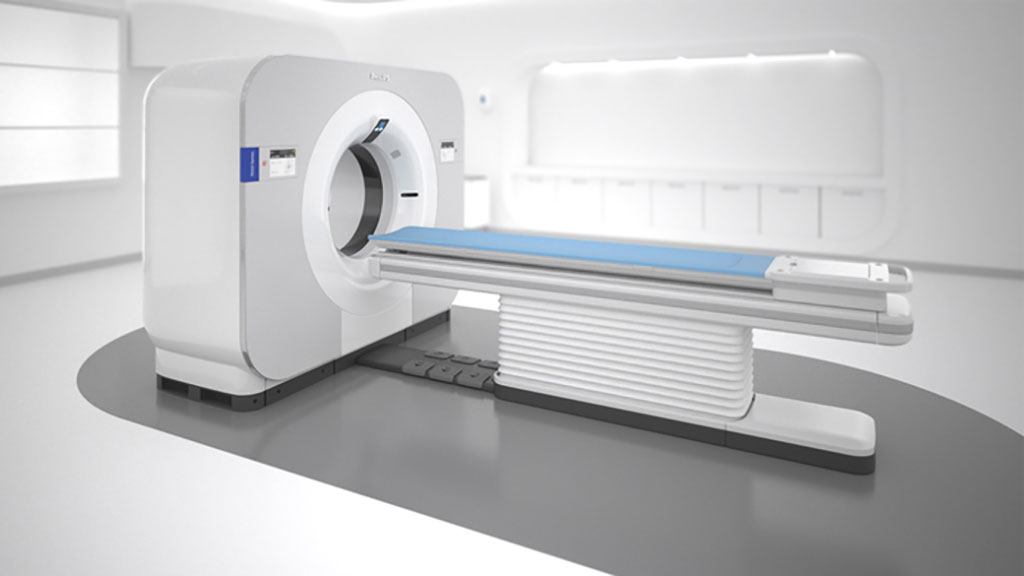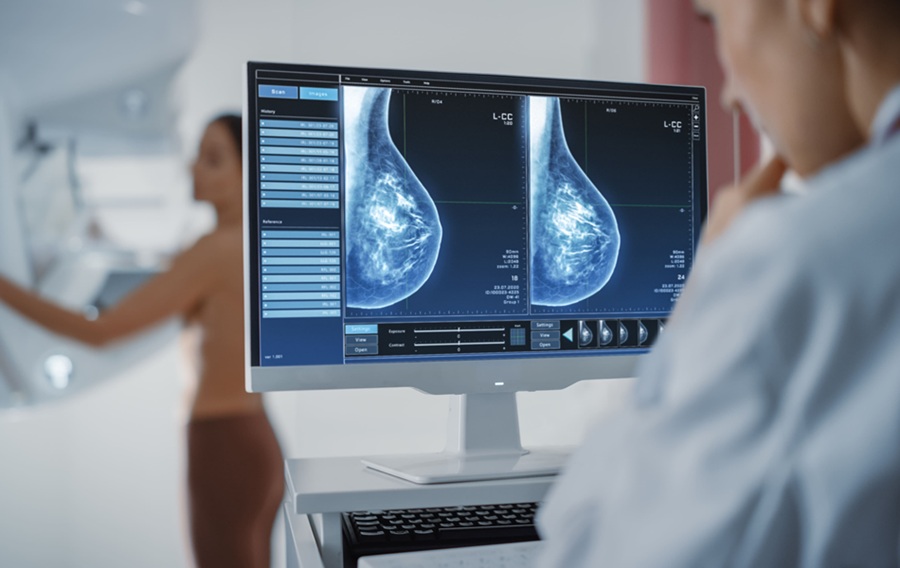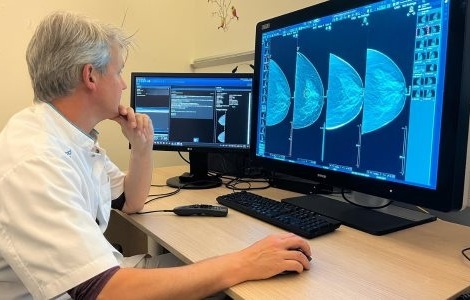Intelligent CT Provides Spectral Data for Precision Diagnosis
|
By MedImaging International staff writers Posted on 08 Jun 2021 |

Image: The Spectral CT 7500 delivers valuable clinical insights (Photo courtesy of Philips)
A fast, always on, spectral computerized tomography (CT) system reduces rescans and follow-ups while using the same dose levels as conventional CT scans.
The Royal Philips (Amsterdam, The Netherlands) Spectral CT 7500 system is designed to deliver high quality spectral images for every patient on every scan 100% of the time to help improve disease characterization. The time-saving spectral workflow is fully integrated, enabling the technologist to get the patient on and off the table quickly, while still delivering high quality imaging that allows the physician to rapidly deliver a confident diagnosis and effective treatment plan for each patient.
System features include a fast scanning table that can accommodate patients up to 330 kg and an 80 cm bore to accommodate larger patients. Cardiac CT scans can be performed in the sub-millisievert range. The system also offers larger anatomic scanning coverage per eight cm rotation. Dual-energy scanning is performed on tube and detector, which reduces cost, weight and imaging protocol requirements for create spectral scans. And since the spectral data is included in all scans, the radiologist can go back and retrospectively look at the scan at different energies.
“With such great human and financial costs due to misdiagnosis, Spectral CT 7500 sets a new standard of care where image quality, dose and workflow come together to deliver valuable clinical insights,” said Kees Wesdorp, chief business leader of precision diagnosis at Philips.. “This helps to bring clarity to defining moments in healthcare by delivering on certainty, simplicity, and reliability in every clinical area from cardiac care, to emergency radiology, diagnostic oncology, intervention and radiation oncology.”
“We rely on CT scans to provide us valuable insights. But conventional CT scanners are limited and can only show us where things are located, like lesions, cysts, bleeds, fractures and more. Philips spectral detector-based systems help to characterize what the finding is, not just where it is, providing us greater confidence in diagnoses,” said consultant radiologist, Finn Rasmussen, MD, DMSc, of Aarhus University (Denmark). “We have seen significant reductions in rescans and follow-ups by adopting spectral into our workflow for faster and more accurate diagnosis.”
Spectral CT, also known as dual-energy CT, measures tissue attenuation at two different energy levels, allowing computation of the two physical effects responsible for x-ray attenuation, the photoelectric effect and Compton scatter. Multiple spectral images can be created that show the attenuation that would result from a monochromatic x-ray source, iodine maps, effective atomic number maps, and ED maps. These spectral data have been shown to improve contrast enhancement, reduce artifacts, and better characterize tissues.
The Royal Philips (Amsterdam, The Netherlands) Spectral CT 7500 system is designed to deliver high quality spectral images for every patient on every scan 100% of the time to help improve disease characterization. The time-saving spectral workflow is fully integrated, enabling the technologist to get the patient on and off the table quickly, while still delivering high quality imaging that allows the physician to rapidly deliver a confident diagnosis and effective treatment plan for each patient.
System features include a fast scanning table that can accommodate patients up to 330 kg and an 80 cm bore to accommodate larger patients. Cardiac CT scans can be performed in the sub-millisievert range. The system also offers larger anatomic scanning coverage per eight cm rotation. Dual-energy scanning is performed on tube and detector, which reduces cost, weight and imaging protocol requirements for create spectral scans. And since the spectral data is included in all scans, the radiologist can go back and retrospectively look at the scan at different energies.
“With such great human and financial costs due to misdiagnosis, Spectral CT 7500 sets a new standard of care where image quality, dose and workflow come together to deliver valuable clinical insights,” said Kees Wesdorp, chief business leader of precision diagnosis at Philips.. “This helps to bring clarity to defining moments in healthcare by delivering on certainty, simplicity, and reliability in every clinical area from cardiac care, to emergency radiology, diagnostic oncology, intervention and radiation oncology.”
“We rely on CT scans to provide us valuable insights. But conventional CT scanners are limited and can only show us where things are located, like lesions, cysts, bleeds, fractures and more. Philips spectral detector-based systems help to characterize what the finding is, not just where it is, providing us greater confidence in diagnoses,” said consultant radiologist, Finn Rasmussen, MD, DMSc, of Aarhus University (Denmark). “We have seen significant reductions in rescans and follow-ups by adopting spectral into our workflow for faster and more accurate diagnosis.”
Spectral CT, also known as dual-energy CT, measures tissue attenuation at two different energy levels, allowing computation of the two physical effects responsible for x-ray attenuation, the photoelectric effect and Compton scatter. Multiple spectral images can be created that show the attenuation that would result from a monochromatic x-ray source, iodine maps, effective atomic number maps, and ED maps. These spectral data have been shown to improve contrast enhancement, reduce artifacts, and better characterize tissues.
Latest General/Advanced Imaging News
- 3D Scanning Approach Enables Ultra-Precise Brain Surgery
- AI Tool Improves Medical Imaging Process by 90%
- New Ultrasmall, Light-Sensitive Nanoparticles Could Serve as Contrast Agents
- AI Algorithm Accurately Predicts Pancreatic Cancer Metastasis Using Routine CT Images
- Cutting-Edge Angio-CT Solution Offers New Therapeutic Possibilities
- Extending CT Imaging Detects Hidden Blood Clots in Stroke Patients
- Groundbreaking AI Model Accurately Segments Liver Tumors from CT Scans
- New CT-Based Indicator Helps Predict Life-Threatening Postpartum Bleeding Cases
- CT Colonography Beats Stool DNA Testing for Colon Cancer Screening
- First-Of-Its-Kind Wearable Device Offers Revolutionary Alternative to CT Scans
- AI-Based CT Scan Analysis Predicts Early-Stage Kidney Damage Due to Cancer Treatments
- CT-Based Deep Learning-Driven Tool to Enhance Liver Cancer Diagnosis
- AI-Powered Imaging System Improves Lung Cancer Diagnosis
- AI Model Significantly Enhances Low-Dose CT Capabilities
- Ultra-Low Dose CT Aids Pneumonia Diagnosis in Immunocompromised Patients
- AI Reduces CT Lung Cancer Screening Workload by Almost 80%
Channels
Radiography
view channel
X-Ray Breakthrough Captures Three Image-Contrast Types in Single Shot
Detecting early-stage cancer or subtle changes deep inside tissues has long challenged conventional X-ray systems, which rely only on how structures absorb radiation. This limitation keeps many microstructural... Read more
AI Generates Future Knee X-Rays to Predict Osteoarthritis Progression Risk
Osteoarthritis, a degenerative joint disease affecting over 500 million people worldwide, is the leading cause of disability among older adults. Current diagnostic tools allow doctors to assess damage... Read moreMRI
view channel
Novel Imaging Approach to Improve Treatment for Spinal Cord Injuries
Vascular dysfunction in the spinal cord contributes to multiple neurological conditions, including traumatic injuries and degenerative cervical myelopathy, where reduced blood flow can lead to progressive... Read more
AI-Assisted Model Enhances MRI Heart Scans
A cardiac MRI can reveal critical information about the heart’s function and any abnormalities, but traditional scans take 30 to 90 minutes and often suffer from poor image quality due to patient movement.... Read more
AI Model Outperforms Doctors at Identifying Patients Most At-Risk of Cardiac Arrest
Hypertrophic cardiomyopathy is one of the most common inherited heart conditions and a leading cause of sudden cardiac death in young individuals and athletes. While many patients live normal lives, some... Read moreUltrasound
view channel
Wearable Ultrasound Imaging System to Enable Real-Time Disease Monitoring
Chronic conditions such as hypertension and heart failure require close monitoring, yet today’s ultrasound imaging is largely confined to hospitals and short, episodic scans. This reactive model limits... Read more
Ultrasound Technique Visualizes Deep Blood Vessels in 3D Without Contrast Agents
Producing clear 3D images of deep blood vessels has long been difficult without relying on contrast agents, CT scans, or MRI. Standard ultrasound typically provides only 2D cross-sections, limiting clinicians’... Read moreNuclear Medicine
view channel
PET Imaging of Inflammation Predicts Recovery and Guides Therapy After Heart Attack
Acute myocardial infarction can trigger lasting heart damage, yet clinicians still lack reliable tools to identify which patients will regain function and which may develop heart failure.... Read more
Radiotheranostic Approach Detects, Kills and Reprograms Aggressive Cancers
Aggressive cancers such as osteosarcoma and glioblastoma often resist standard therapies, thrive in hostile tumor environments, and recur despite surgery, radiation, or chemotherapy. These tumors also... Read more
New Imaging Solution Improves Survival for Patients with Recurring Prostate Cancer
Detecting recurrent prostate cancer remains one of the most difficult challenges in oncology, as standard imaging methods such as bone scans and CT scans often fail to accurately locate small or early-stage tumors.... Read moreImaging IT
view channel
New Google Cloud Medical Imaging Suite Makes Imaging Healthcare Data More Accessible
Medical imaging is a critical tool used to diagnose patients, and there are billions of medical images scanned globally each year. Imaging data accounts for about 90% of all healthcare data1 and, until... Read more
Global AI in Medical Diagnostics Market to Be Driven by Demand for Image Recognition in Radiology
The global artificial intelligence (AI) in medical diagnostics market is expanding with early disease detection being one of its key applications and image recognition becoming a compelling consumer proposition... Read moreIndustry News
view channel
GE HealthCare and NVIDIA Collaboration to Reimagine Diagnostic Imaging
GE HealthCare (Chicago, IL, USA) has entered into a collaboration with NVIDIA (Santa Clara, CA, USA), expanding the existing relationship between the two companies to focus on pioneering innovation in... Read more
Patient-Specific 3D-Printed Phantoms Transform CT Imaging
New research has highlighted how anatomically precise, patient-specific 3D-printed phantoms are proving to be scalable, cost-effective, and efficient tools in the development of new CT scan algorithms... Read more
Siemens and Sectra Collaborate on Enhancing Radiology Workflows
Siemens Healthineers (Forchheim, Germany) and Sectra (Linköping, Sweden) have entered into a collaboration aimed at enhancing radiologists' diagnostic capabilities and, in turn, improving patient care... Read more



















